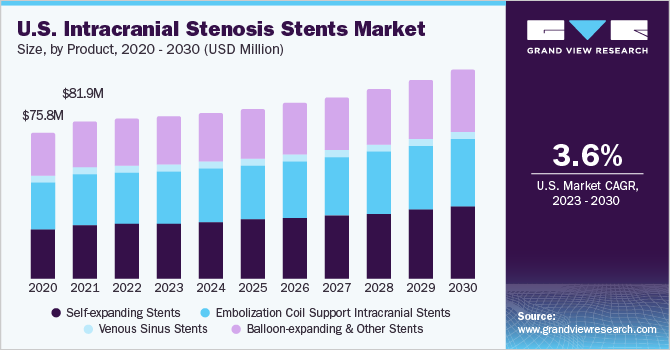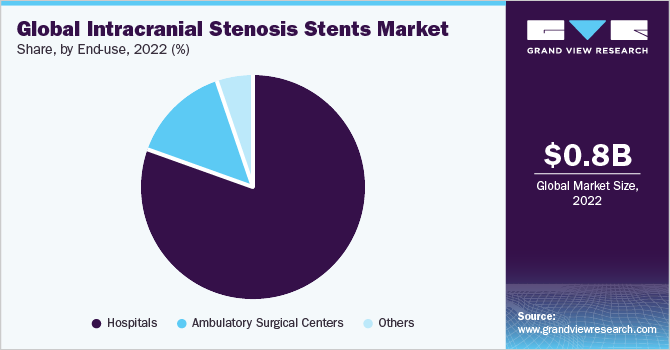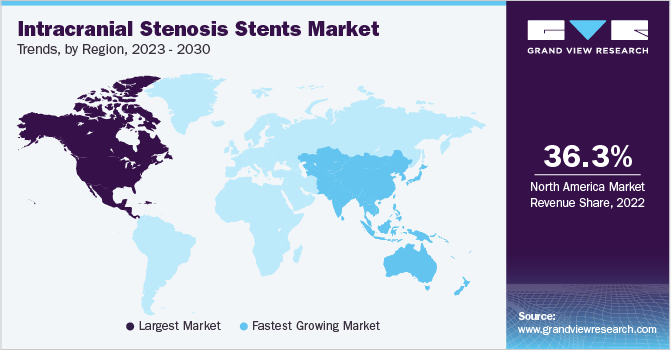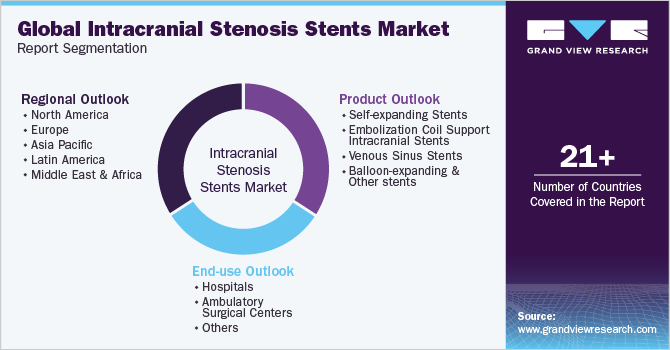
Intracranial Stenosis Stents Market Size, Share & Trends Analysis Report By Product (Self-expanding Stents, Embolization Coil Support Intracranial Stents, Venous Sinus Stents, Balloon-expanding), By End-use, By Region, And Segment Forecasts, 2023 - 2030
- Report ID: GVR-4-68040-070-9
- Number of Pages: 130
- Format: Electronic (PDF)
- Historical Range: 2018 - 2021
- Industry:Healthcare
Report Overview
The globalintracranial stenosis stents market sizewas valued atUSD 0.79 billion in 2022and is projected to grow at a compound annual growth rate (CAGR) of 4.8% from 2023 to 2030. The market is growing due to factors such as the rising incidence of stroke, increasing demand for minimally invasive intracranial surgeries, and the constantly growing geriatric population. For instance, according to a report from the World Stroke Organization from 2022, there are more than 12.2 million new stroke cases recorded annually worldwide. In addition, according to the same source, stroke is the most prevalent condition in people aged 70 years and older (67%), followed by those between the ages of 15 and 49 (22%). This factor is expected to fuel market growth over the coming years.

Minimally invasive surgeries are gaining popularity due to the reduced risk and trauma associated with these procedures. Smaller incisions decrease postoperative pain and facilitate speedy recovery, leading to the high adoption of these procedures. Several key players are heavily investing in R&D activities for the launch of innovative minimally invasive surgical instruments.
Cerebrovascular complications related to intracranial stenting refer to adverse events that can occur during or after the procedure, which affects the blood vessels and blood flow in the brain. The major cerebrovascular complications after an intracranial stenting procedure may be linked to low-volume locations, posterior circulation stenosis, and the stenting procedure itself.
For instance, according to a study published in the Journal of Stroke and Cerebrovascular Diseases, balloon-expandable intracranial stent placement can produce satisfactory outcomes in 97% of stable patients and 67% of unstable patients. Within the first 30 days following the procedure, 10% of cerebral stents were associated with adverse events, which included fatalities, one from a myocardial infarction (4%) mild stroke, and three major stroke cases.
The shortage of skilled professionals in intracranial stenosis stenting is a significant concern in many countries globally. Intracranial stenosis stenting is a highly specialized procedure that requires extensive training and experience to be performed safely & effectively. The shortage of trained professionals can limit access to this potentially life-saving treatment for patients, which restricts the growth of the intracranial stenosis stents market.
In the U.S., a shortage of neuro-interventionalists has been reported in some regions. This can limit access to specialized treatments such as intracranial stenosis stenting for patients with neurological conditions. A survey of U.S. healthcare providers published in the Journal of Stroke and Cerebrovascular Diseases in 2018 stated that only 40% of respondents reported feeling comfortable performing intracranial stenting procedures. Moreover, concerns about patient safety, lack of access to training programs, and limited reimbursement were identified as major barriers to developing expertise in this area.
The COVID-19 pandemic is estimated to have had a modest impact on the market in the short term. As the pandemic gradually came under control and the healthcare sector began to recover, the demand for intracranial stenosis stents increased. In addition, technological advancements in stent design and materials are driving growth in the market. For instance, in August 2020, Stryker received U.S. FDA approval for an expanded indication of its Neuroform Atlas Stent System. Such strategic initiatives are expected to drive the market during the forecast period.
Product Insights
Based on product, the self-expanding stents segment dominated the market with 34.86% of the revenue share in 2022. Intracranial stenosis is associated with the risk of ischemic stroke; however, research has shown that Self-Expandable Stents (SES) are likely to be safe for flow restoration in cases of acute ischemic strokes.
For instance, according to the CDC, stroke is a major cause of long-term disability. In addition, it reduces mobility in more than half of stroke survivors aged 65 and above. Therefore, intracranial stenosis stents are designed to prevent heart-attack occurrence through a self-expanding feature, where the deployed stent expands and holds the vessel open.
The growth of the embolization coil support intracranial stents segment is driven by the rising incidence of brain strokes, increasing target population, advancements in technology, improvements in healthcare facilities, and adoption of new surgical options. Due to these factors, the usage of stent-assisted coiling will continue to increase, thus leading to the growth of the segment. The use of embolization coil support intracranial stents has been one of the key options for treating intracranial stenosis.
End-use Insights
The hospital end-use segment dominated with 80.8% of the market share, which can be attributed to the rising prevalence of stenosis, aneurysm, brain stroke, and neurovascular diseases. The increasing demand for products such as self-expanding stents, venous sinus stents, and balloon-expanding & other stents in neurosurgery has led to increased sales of products. Moreover, the adoption of new technology-based devices in hospitals is a key factor for market growth. Alternatively, the rising number of neurosurgeries performed in hospitals has further led to the growth of the market.

The ambulatory surgical center segment is expected to witness growth at a rapid pace over the estimated period. Ambulatory surgery centers are focusing on renovating offering in healthcare delivery with different facilities for brain-related injuries as well as new growth opportunities for medical devices and equipment. Ambulatory surgical centers offer low-risk procedures in a more convenient setting at lower rates than hospitals.
Regional Insights
North America accounted for the largest share of 36.3% in 2022. The regional growth is driven by the high incidence rates of hypertension & stroke and the presence of well-established healthcare facilities. According to the CDC, in 2020, approximately 670,000 deaths in the U.S. had hypertension as the primary contributing cause. Moreover, as per CDC, around 87% of strokes are ischemic strokes, where blood flow to the brain is blocked. Increasing demand for minimally invasive procedures and the rising prevalence of intracranial stenosis cases are expected to fuel market growth over the coming years.

The Asia Pacific market for intracranial stenosis stents is expected to grow at the fastest rate of 5.7% over the forecast period. This can be attributed to factors such as the growing aging population, negative lifestyle choices & stress, rising incidence of ischemic stroke, large population, and increasing patient affordability in the region. Moreover, lucrative growth opportunities in developing economies, such as India and China, are likely to contribute to regional market growth.
Major global players are contributing to the market growth in the region by receiving approvals from authorities or expanding their product portfolios. For instance, in December 2020, MicroPort Scientific Corporation received approval from China’s National Medical Products Administration (NMPA) for its Bridge Vertebral Drug-Eluting Stent to treat symptomatic vertebral artery stenosis in China.
Key Companies & Market Share Insights
Major players are engaging in the innovation of intracranial stenosis stents and focusing on clinical trials to strengthen their product portfolios & manufacturing capacities and provide competitive differentiation. For instance, in August 2022, MicroPort Scientific Corporation announced that the NeuroTech APOLLO Intracranial Arterial Stent System had completed its first implantation in Brazil. Some of the key players in the global intracranial stenosis stents market include:
phenox GmbH
Medtronic
Acandis GmbH
MicroPort Scientific Corporation
MicroVention, Inc.
CERENOVUS (Johnson & Johnson)
Sino Medical Sciences Technology, Inc.
Stryker
Balt
Intracranial Stenosis Stents Market Report Scope
Report Attribute |
Details |
The market size value in 2023 |
USD 0.81 billion |
The revenue forecast in 2030 |
USD 1.1 billion |
Growth rate |
CAGR of 4.8% from 2023 to 2030 |
The base year for estimation |
2022 |
Historical data |
2018 - 2021 |
Forecast period |
2023 - 2030 |
Quantitative units |
Revenue in USD billion, and CAGR from 2023 to 2030 |
Report coverage |
Revenue forecast, company share, competitive landscape, growth factors, and trends |
部分覆盖 |
Product, end-use, region |
Regional scope |
North America; Europe; Asia Pacific; Latin America; Middle East & Africa |
Country scope |
U.S.; Canada; UK; Germany; France; Spain; Italy; Sweden; Norway; Denmark; Japan; China; India; South Korea; Australia; Thailand; Brazil; Mexico; Argentina; South Africa; UAE; Saudi Arabia; Kuwait |
Key companies profiled |
phenox GmbH; Medtronic; Acandis GmbH; MicroPort Scientific Corporation; MicroVention, Inc.; CERENOVUS (Johnson & Johnson); Sino Medical Sciences Technology, Inc.; Stryker; Balt |
Customization scope |
Free report customization (equivalent up to 8 analysts working days) with purchase. Addition or alteration to country, regional & segment scope. |
革命制度党cing and purchase options |
利用定制购买选项来满足您的穰ct research needs.Explore purchase options |
Global Intracranial Stenosis Stents Market Report Segmentation
This report forecasts revenue growth at global, regional, & country levels and provides an analysis of the latest industry trends in each of the sub-segments from 2018 to 2030. For the purpose of this study, Grand View Research has segmented the global intracranial stenosis stents market report based on product, end-use, and region:

Product Outlook (Revenue, USDBillion, 2018 - 2030)
Self-expanding Stents
Embolization Coil Support Intracranial Stents
Venous Sinus Stents
Balloon-expanding & Other Stents
End-use Outlook (Revenue, USDBillion, 2018 - 2030)
Hospitals
Ambulatory Surgical Centers
Others
Regional Outlook (Revenue, USDBillion, 2018 - 2030)
North America
U.S.
Canada
Europe
英国
Germany
France
Spain
Italy
Sweden
Norway
Denmark
Asia Pacific
China
Japan
India
South Korea
Australia
Thailand
Latin America
巴西
Mexico
Argentina
MEA
South Africa
Saudi Arabia
UAE
Kuwait
Frequently Asked Questions About This Report
b.The global intracranial stenosis stents market size was estimated at USD 0.79 billion in 2022 and is expected to reach USD 0.81 billion in 2023.
b.The global intracranial stenosis stents market is expected to grow at a compound annual growth rate of 4.8% from 2023 to 2030 to reach USD 1.1 billion by 2030
b.Self-expanding stents dominated the market with 34.86% share in 2022, owing to the high prevalence of ischemic strokes
b.一些关键球员在颅内ste操作nosis stents market include phenox GmbH; Medtronic; Acandis GmbH; MicroPort Scientific Corporation; MicroVention, Inc.; CERENOVUS (Johnson & Johnson); Sino Medical Sciences Technology, Inc.; Stryker; Balt
b.The intracranial stenosis stents market is growing due to factors like the rising incidence of stroke, increasing demand for minimally invasive intracranial surgeries, and growing geriatric population





